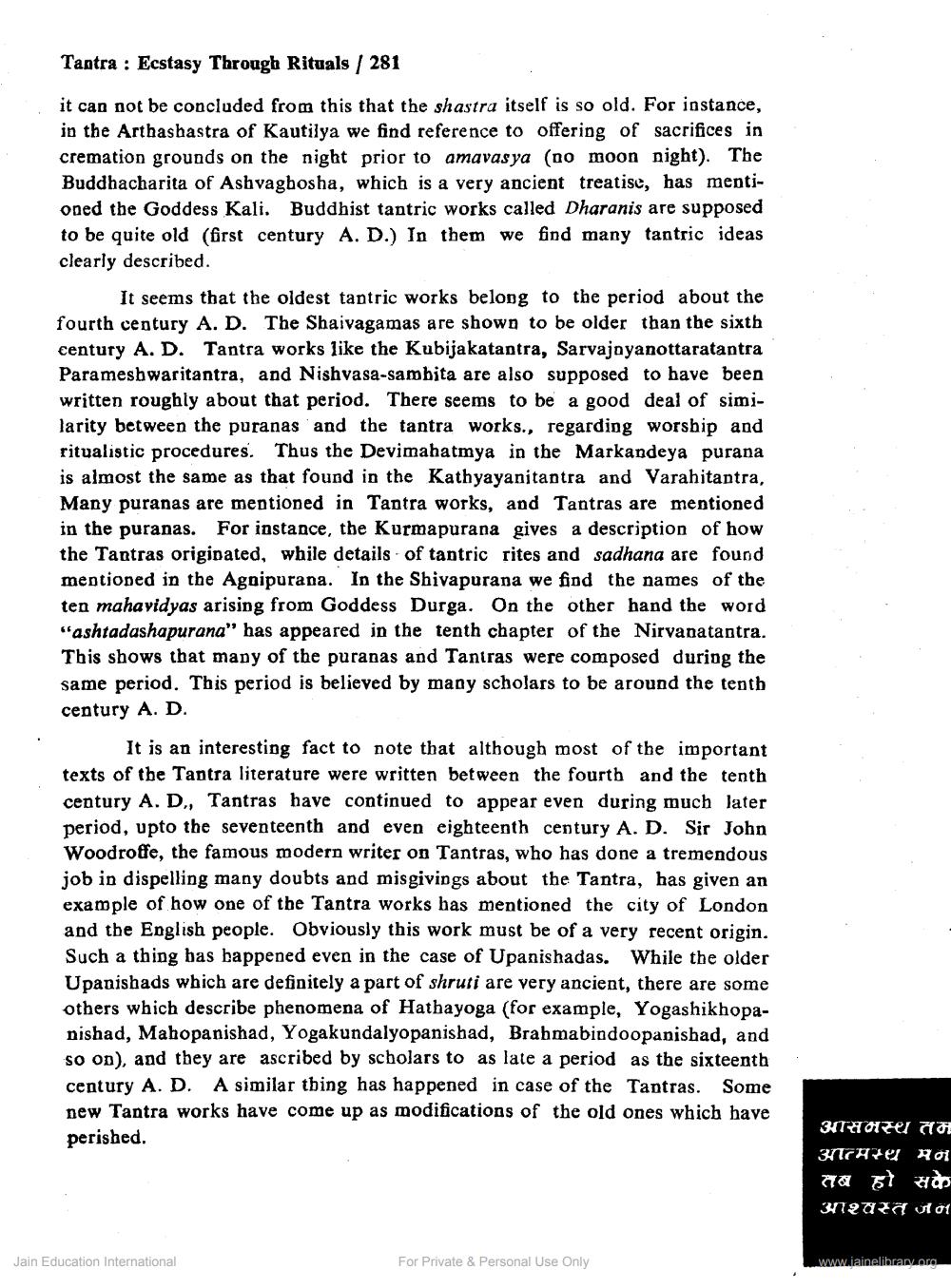Book Title: Tantra Ecstasy Through Rituals Author(s): Kalidas S Joshi Publisher: Z_Umravkunvarji_Diksha_Swarna_Jayanti_Smruti_Granth_012035.pdf View full book textPage 4
________________ Tantra : Ecstasy Through Rituals / 281 it can not be concluded from this that the shastra itself is so old. For instance, in the Arthashastra of Kautilya we find reference to offering of sacrifices in cremation grounds on the night prior to amavasya (no moon night). The Buddhacharita of Ashvaghosha, which is a very ancient treatise, has mentioned the Goddess Kali. Buddhist tantric works called Dharanis are supposed to be quite old (first century A. D.) In them we find many tantric ideas clearly described. It seems that the oldest tantric works belong to the period about the fourth century A. D. The Shaivagamas are shown to be older than the sixth century A. D. Tantra works like the Kubijakatantra, Sarvajayanottaratantra Parameshwaritantra, and Nishvasa-sambita are also supposed to have been written roughly about that period. There seems to be a good deal of similarity between the puranas and the tantra works., regarding worship and ritualistic procedures. Thus the Devimahatmya in the Markandeya purana is almost the same as that found in the Kathyayanitantra and Varahitantra, Many puranas are mentioned in Tantra works, and Tantras are mentioned in the puranas. For instance, the Kurmapurana gives a description of how the Tantras originated, while details of taptric rites and sadhana are found mentioned in the Agaipurana. In the Shivapurana we find the names of the ten mahavidyas arising from Goddess Durga. On the other hand the word "ashtadashapurana" has appeared in the tenth chapter of the Nirvanatantra. This shows that many of the puranas and Tantras were composed during the same period. This period is believed by many scholars to be around the tenth century A. D. It is an interesting fact to note that although most of the important texts of the Tantra literature were written between the fourth and the tenth century A. D., Tantras have continued to appear even during much later period, upto the seventeenth and even eighteenth century A. D. Sir John Woodroffe, the famous modern writer on Tantras, who has done a tremendous job in dispelling many doubts and misgivings about the Tantra, has given an example of how one of the Tantra works has mentioned the city of London and the English people. Obviously this work must be of a very recent origin. Such a thing bas bappened even in the case of Upanishadas. While the older Upanishads which are definitely a part of shruti are very ancient, there are some others which describe phenomena of Hathayoga (for example, Yogashikhopanishad, Mahopanishad, Yogakundalyopanishad, Brahmabindoopanishad, and so on), and they are ascribed by scholars to as late a period as the sixteenth century A. D. A similar thing has happened in case of the Tantras. Some new Tantra works have come up as modifications of the old ones which have perished. आसमस्थ तमा आत्मस्थ मन तब हो सके आश्वस्त जन Jain Education International For Private & Personal Use Only www.iainelibrary.orgPage Navigation
1 2 3 4 5 6 7 8 9 10 11 12 13
